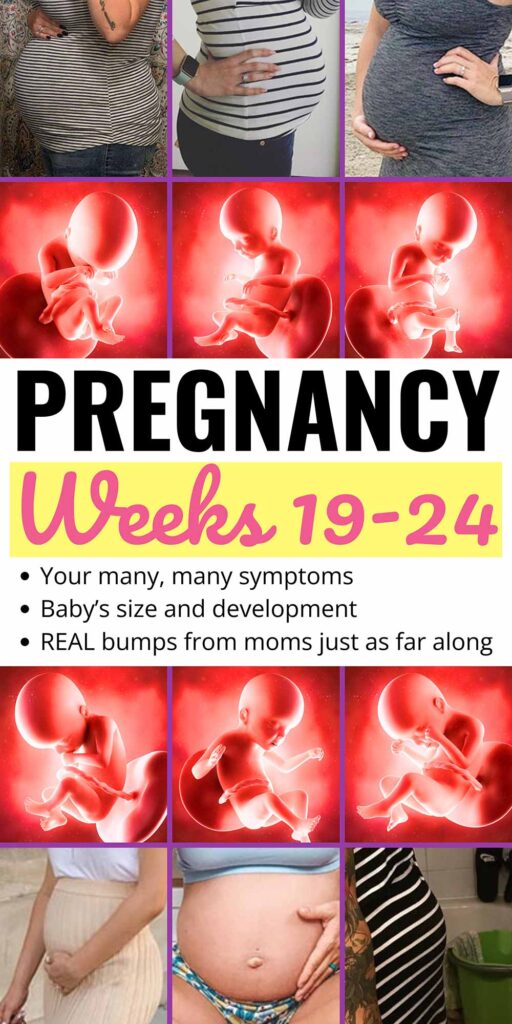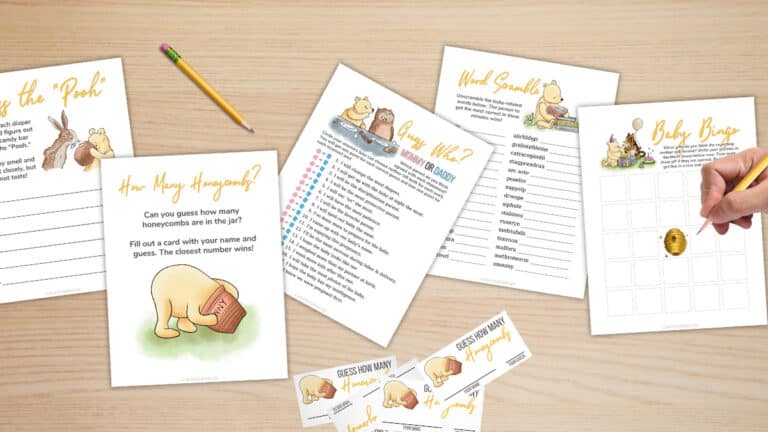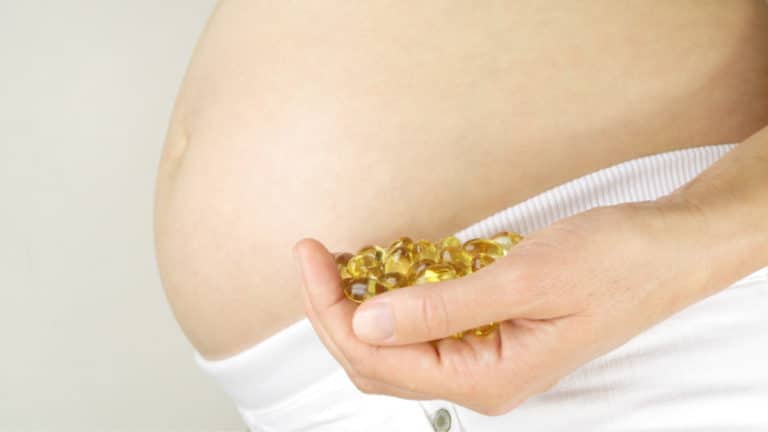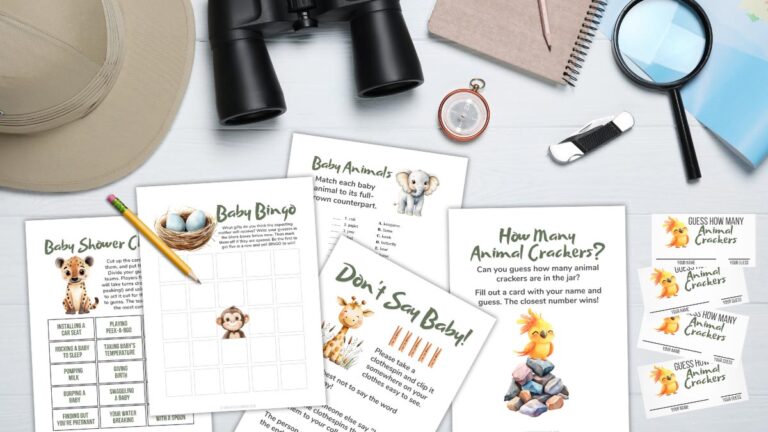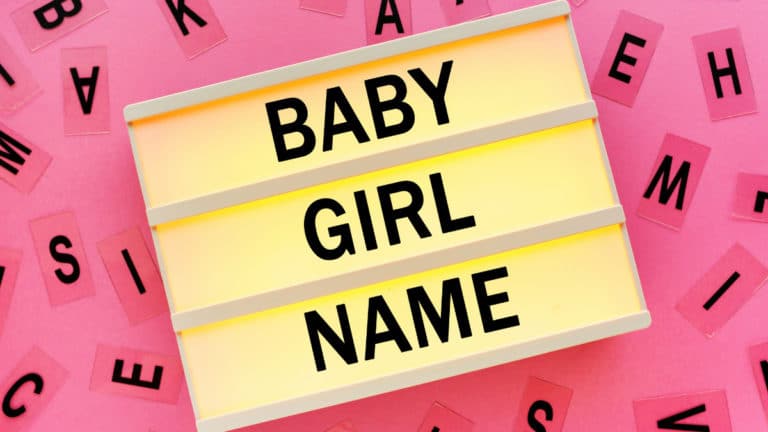You’re finally showing and you feel better than ever! Weeks 19-24 are the best few weeks of pregnancy for most women, so enjoy it while it lasts. It’s about to get crazy!
Choose Your Week
- Pregnancy Week 19
- Pregnancy Week 20
- Pregnancy Week 21
- Pregnancy Week 22
- Pregnancy Week 23
- Pregnancy Week 24
Sources of information included in this series include What to Expect, American Pregnancy Association, several specific sources cited within the text, and my personal experience as a biological mother of two!
Pregnancy Week 19 Development
How many months pregnant is 19 weeks?
19 weeks equals four-and-a-half months pregnant!
Where is the baby located at 19 weeks?
Baby’s still got quite a swimming pool to move around in, and could literally be sitting up on her butt or doing a headstand. But at this point, most babies rest in a position with their head in your rib cage (ouch!) and their feet in your pelvis (kicking your bladder, naturally).
What does a baby look like at 19 weeks?
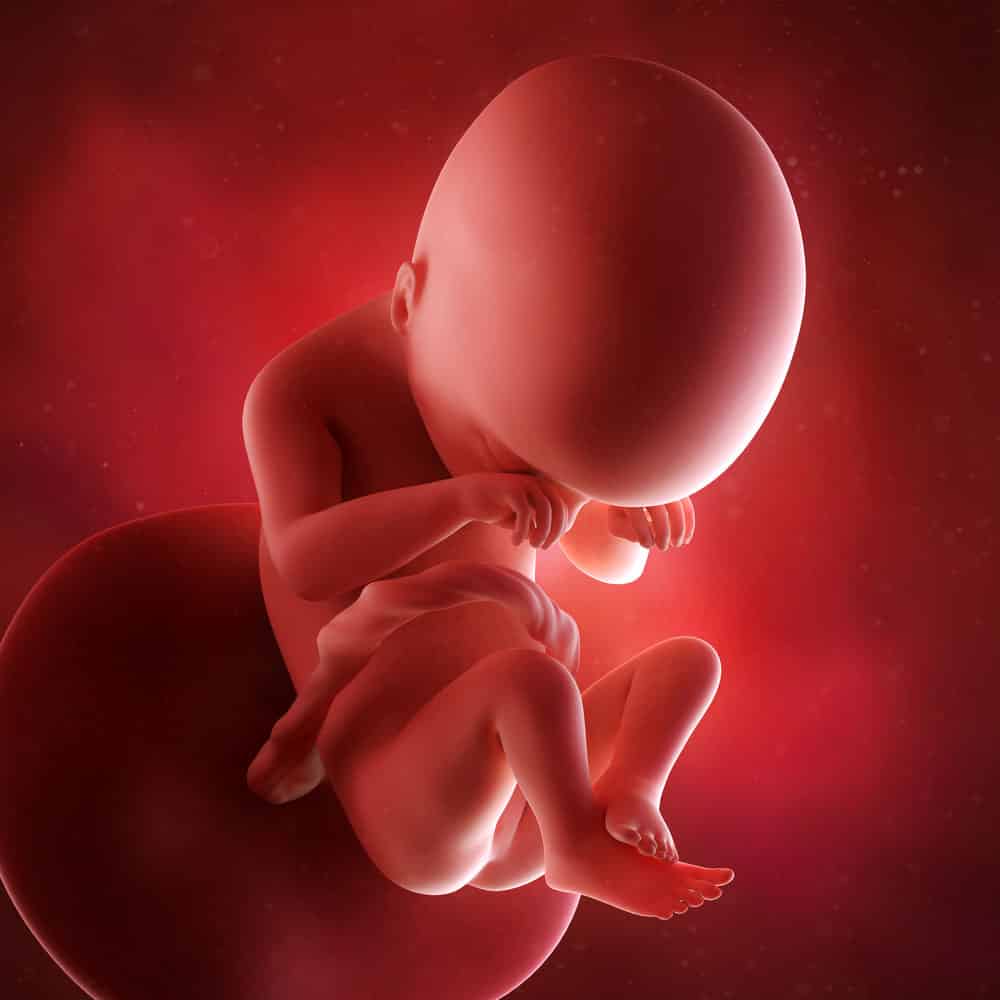
- Average fetal length at 19 weeks: 6.5 inches
- Average fetal weight at 19 weeks: 7.5 ounces
Your baby might suddenly look like it’s been rolling around in a combination of candle wax and white queso cheese dip, but there’s a scientific name for that white, greasy coating: vernix caseosa. This is the mother of all moisturizers, protecting the baby’s skin and keeping it from looking like a little, wrinkled old person at birth (due to living in amniotic fluid).
The main airwaves of the lungs (bronchioles) are forming this week as well. Hair is sprouting on the head. Baby girls already have 6 million eggs tucked inside their ovaries!
Pregnancy Week 19 Symptoms & Baby Bump
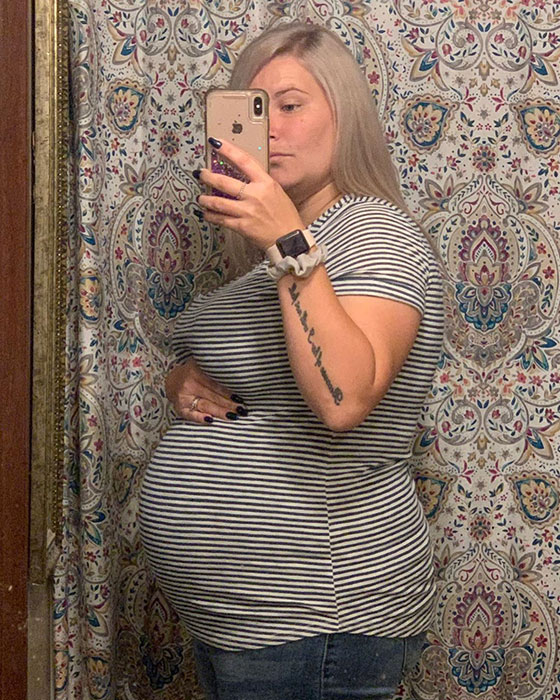
At some point during pregnancy, virtually every woman will experience swelling (aka edema), particularly in the hands, ankles, and feet. This is fluid retention, and there’s not much you can do about it other than drinking plenty of water and keeping your feet propped up. Even if you’re not someone normally affected by swelling, you probably will be during pregnancy. I’d never swelled up because of PMS or salt a single time in my life, but I had severe swelling during both pregnancies that lasted well after childbirth. Fluid retention should go away a few weeks after the baby’s born, so hang in there!
Swelling isn’t the only thing that’ll have you buying a shoe size up – your feet may actually GROW during pregnancy, and they might even stay at their new, larger size. Relaxin is a hormone released that helps your ligaments loosen up in preparation for childbirth, and unfortunately, it doesn’t discriminate between your pelvis and your piggies. All your ligaments have the potential to expand, and the amount of pressure your feet carry means they’re most likely to spread. A permanently elongated foot isn’t guaranteed for every woman, though – once my swelling was gone, my feet fit perfectly back into my old shoes!
One other thing is growing rapidly now: your blood supply! Over the course of pregnancy, your body’s total blood supply will double. This means your iron intake is extra important for the rest of your pregnancy. If you’re a meat eater, red meat is king; if you’re vegetarian, put spinach in everything: smoothies, salads, and casseroles!
If you were anemic before pregnancy, it will only get worse, so be sure to tell your OBGYN. I was anemic and already taking a 65mg iron supplement daily prior to pregnancy. My doctor eventually had me taking 65mg in the morning, 65mg in the afternoon, and 65mg in the evening as well as a prenatal vitamin with iron before bed to keep my iron levels at the bare minimum!
Continuing symptoms:
- color-changing breasts
- food cravings
- heartburn
- gas
- vaginal discharge
- constipation
- dizziness
- increased OR decreased sex drive
- varicose veins
- round ligament pain
- increased mucus and oil production
- sensitive gums
- forgetfulness
- stretch marks
- backaches
- leg cramps
Pregnancy Week 19 Video
Pregnancy Week 20 Development
How many months pregnant is 20 weeks?
20 weeks equals four-and-a-half months pregnant!
Where is the baby located at 20 weeks?
This is the halfway point! Coincidentally, around now is when you should be able to feel the top of your uterus (aka the fundus) right at the level of your belly button. It may seem silly, but for me, feeling that firmness at my belly button was a huge deal; maybe it was because I had so much stomach fat and it was harder to feel earlier in the pregnancy.
Many women get an ultrasound right around now, and a marginal placenta previa at 20 weeks pregnant (I mentioned this in the 18 weeks section) is nothing to worry about. That thing is going to keep sliding around in your uterus for the next few weeks. My daughter’s placenta was front and center throughout most of my pregnancy, but ended up at the very top of my uterus at the end – it took a lot of tugging and tapping on my belly to break it loose during my c-section!
Your womb has so much growing to do, the placenta will usually shift positions and correct itself before delivery. However, if you are leaking amniotic fluid at 20 weeks, your doctor will likely do a further evaluation to determine the risk to you and your baby, and prescribe steroids and bed rest.
What does a baby look like at 20 weeks?
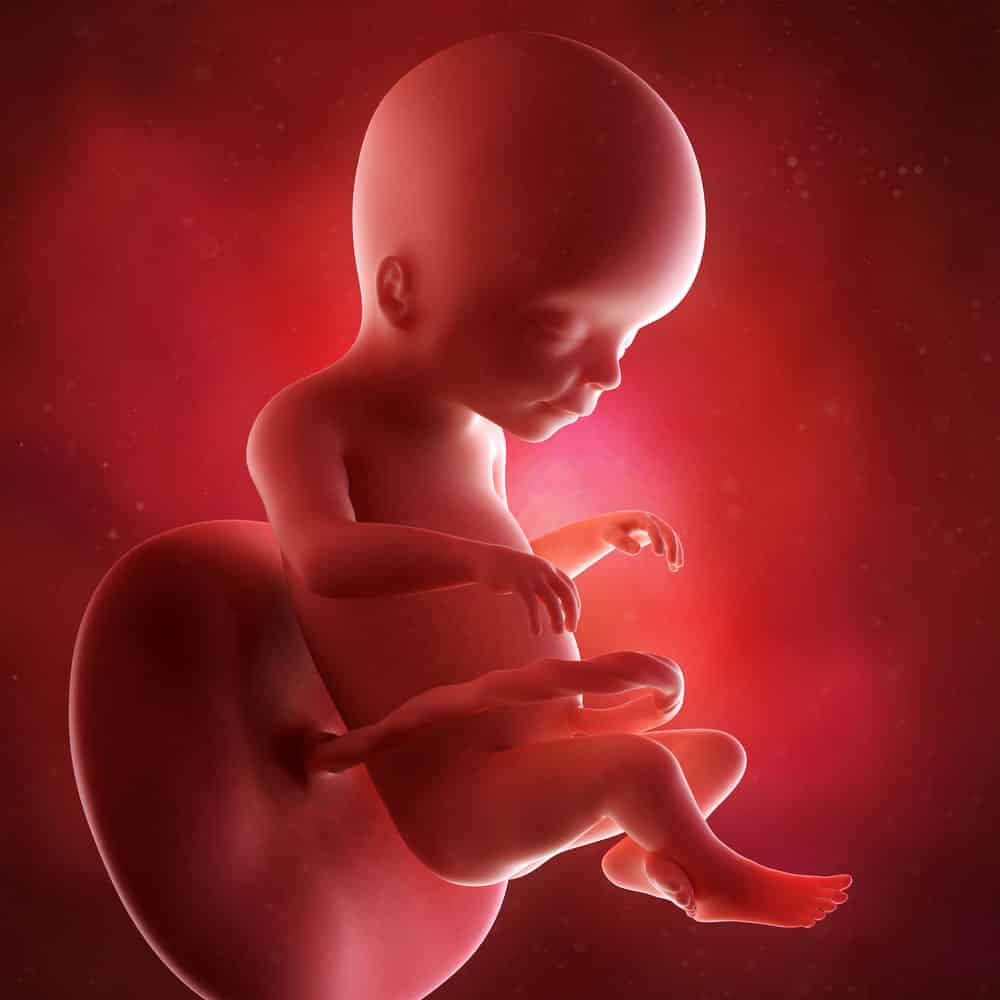
- Average fetal length at 20 weeks: over 7 inches
- Average fetal weight at 20 weeks: 9.5 ounces
Baby’s digestive is building up meconium – the first poop. It’ll look dark green or black and feel sticky. Let your partner change that one; it’s one “first” I was happy to pass up!
If you haven’t gotten a sex reveal ultrasound yet (“gender reveal” is technically incorrect), now is usually the time when most parents have an ultrasound that shows the baby’s genitals clearly (though a boy’s scrotum won’t be fully formed yet). However, not every ultrasound tech is perfect, nor is every baby cooperative enough for an affirmative view, so you should always be prepared for a surprise at birth! The ultrasound may reveal even more adorable details about the baby now, like its ability to suck its thumb – yes, already!
Amniocentesis Risks at 20 Weeks
If your doctor wants to perform an amniocentesis because of a risk of birth defect or abnormal genetic condition, you may feel some concern about such an invasive process. For you (the mom), the risks are minimal – but you may feel some discomfort, stinging, or pressure from the needle and removal of fluid. Very rarely (about 1% of the time), you may have cramping, spotting, or leakage of amniotic fluid, or develop a uterine infection.
For most moms, the bigger concern is the risk to their unborn baby, and it can be a bit more severe: There is a 0.5% chance of miscarriage after an amnio, and if you have any existing infection (including HIV), it can be passed to the baby.
My personal opinion is that if you would have your baby regardless of any birth defect or chromosomal abnormality (like Down syndrome), turn down the amnio. Either way, ultrasounds down the line will often reveal these so you can prepare before birth anyway. And if you have ANY kind of infection, curable or not, I would not do an amniocentesis until the infection has cleared (if possible).
Pregnancy Week 20 Symptoms & Baby Bump

Are you having to tame a wild mane of hair every morning, and find yourself clipping your nails constantly? That’s because they actually are growing faster now, thanks to your increased circulation. Your normal daily hair loss is also suppressed right now, but watch out after delivery – you’ll make up for it, losing it in huge amounts at once! It’s totally normal, though, and your overall normal hair volume should stay the same.
Depending on how thin you were prior to pregnancy, you may see your belly button starting to push its way out already. If you’re overweight, you might not pop a snooze button until closer to delivery. If you’re obese like I was, you’ll probably never have a protruding belly button during pregnancy – but it could become close to flush with the rest of your belly, giving you a shallow bowl to store snacks in! (Kidding.)
Continuing symptoms:
- color-changing breasts
- food cravings
- heartburn
- gas
- vaginal discharge
- constipation
- dizziness
- increased OR decreased sex drive
- varicose veins
- round ligament pain
- increased mucus and oil production
- sensitive gums
- forgetfulness
- stretch marks
- backaches
- leg cramps
- swelling
Pregnancy Week 20 Video
Pregnancy Week 21 Development
How many months pregnant is 21 weeks?
21 weeks equals almost five months pregnant!
Where is the baby located at 21 weeks?
Creeping slowly above your belly button, the baby could be head-down already – but don’t hold your breath for it staying that way! Baby will probably flip many, many times over the next few months until (hopefully) settling in the birthing position. If you feel kicks in your chest, it could be the baby up that high (every pregnancy and body is different), but it’s very likely what you’re feeling is gas bubbles moving and popping throughout your abdominal cavity!
Also, right at 21 weeks into my first pregnancy was when I finally felt my first kick! If you’re worried you’re not feeling your baby move because you’re overweight – don’t. Feeling movement in your uterus has nothing to do with your weight and almost everything to do with the location of both the baby and the placenta. In my case, my daughter had been hiding underneath her placenta for the first half of my pregnancy. I felt my son seven weeks earlier in the pregnancy (and I was still obese)!
What does a baby look like at 21 weeks?
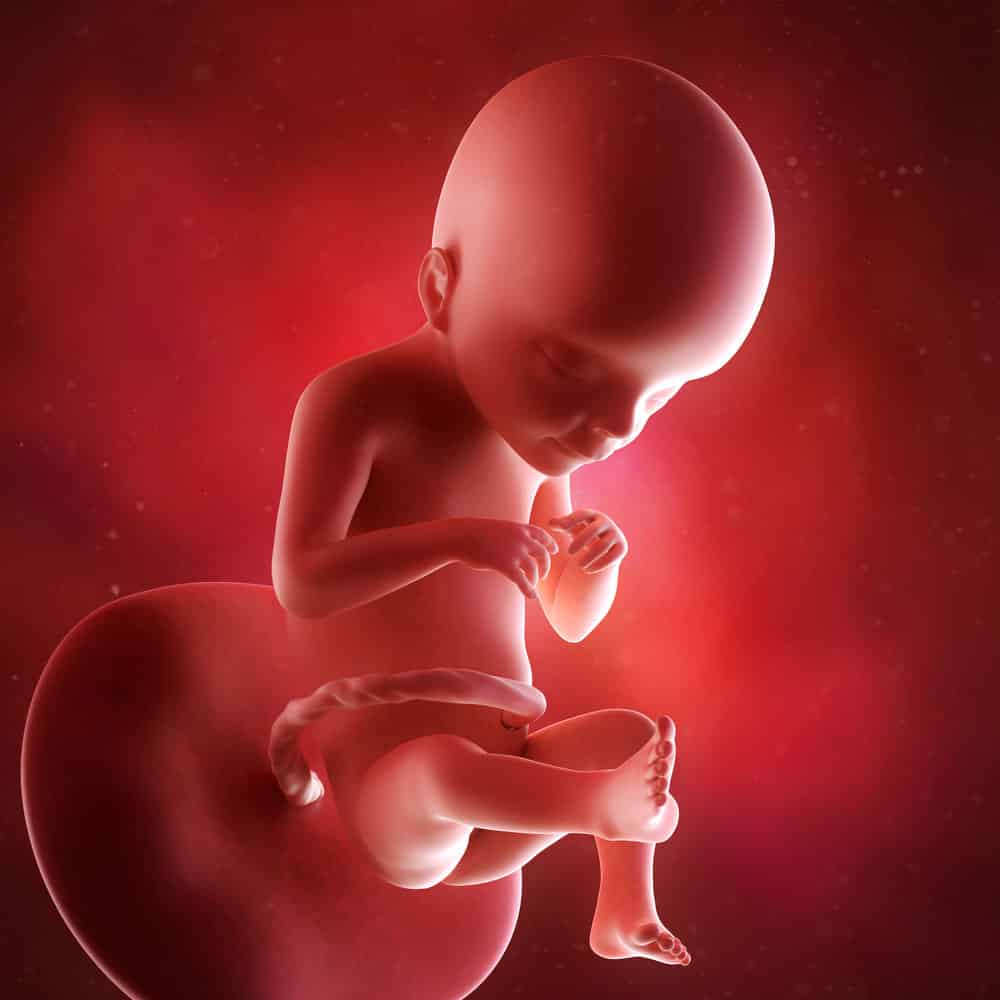
- Average fetal length at 21 weeks: 9.5 inches
- Average fetal weight at 21 weeks: 12 ounces
Baby’s arms and legs are now in proportion to its body, though its head is still on the larger side. And no, your baby didn’t have a massive growth spurt – the length is now measured from head to heel instead of from crown to rump! The liver and spleen have been producing blood cells, but bone marrow is starting to help out now.
And while the placenta will continue to provide the majority of the baby’s “food” until birth, it will also get calories from swallowing amniotic fluid now. Even cooler than that: the baby can taste the foods you eat within the fluid and will prefer them after birth, so eat your veggies daily! Baby is also sleeping for more than half the day. Baby girls’ vaginas are now fully formed but have some more developing to do before birth.
Pregnancy Week 21 Symptoms & Baby Bumps
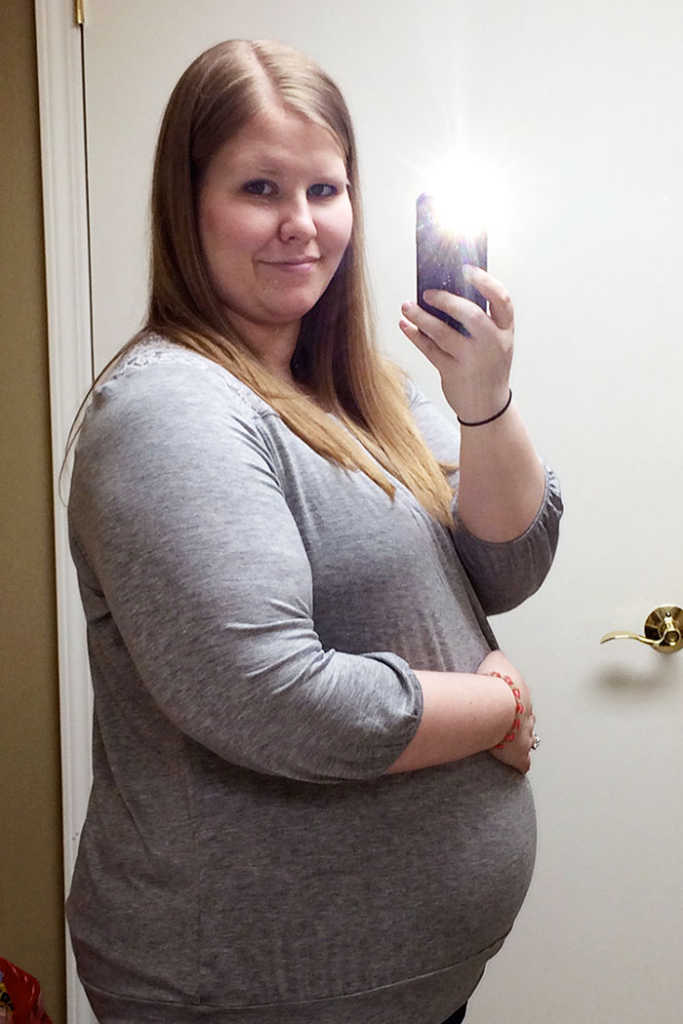
For weeks 21 through 39, I’ve included my own personal baby bump photos to show the progression of a plus-size baby bump through an obese pregnancy (including a shirtless one near the end)! I started this pregnancy at about 275 pounds.

Not much new is happening at this point. However, the closer you get to d-day, the more anxious you probably feel. This is very normal for new (and even repeat moms); the prospect of bringing an entirely new human into the world and being responsible for KEEPING IT ALIVE often doesn’t hit until well after you get pregnant. Talk to your fellow mom friends for reassurance that you’re not alone. More importantly, talk to your partner – they’ll probably be glad they’re not the only one freaking out, too.
If your anxiety is constantly taking over your thoughts or preventing you from participating in your normal activities or social events, talk to your doctor! Once again, the internet is not a substitute for a medical professional.
Continuing symptoms:
- color-changing breasts
- food cravings
- heartburn
- gas
- vaginal discharge
- constipation
- dizziness
- increased OR decreased sex drive
- varicose veins
- round ligament pain
- increased mucus and oil production
- sensitive gums
- forgetfulness
- stretch marks
- backaches
- leg cramps
- swelling
- fast-growing hair and nails
Pregnancy Week 21 Video
Pregnancy Week 22 Development
How many months pregnant is 22 weeks?
22 weeks equals five months pregnant!
Where is the baby located at 22 weeks?
Baby’s getting pretty big by now, and your fundus (the top of your uterus) can be felt somewhere about an inch above your belly button.
This is when I started to look really friggin’ pregnant (and not just fat) because the bulk of my stomach fat is below my belly button. Having a round, firm bump above it finally let people know I was patting a baby under there, and not just the personal deep-dish pizza I’d eaten for lunch. If you’re overweight and more barrel-shaped than pear-shaped, it may be a bit longer before you have a noticeable bump.
What does a baby look like at 22 weeks?
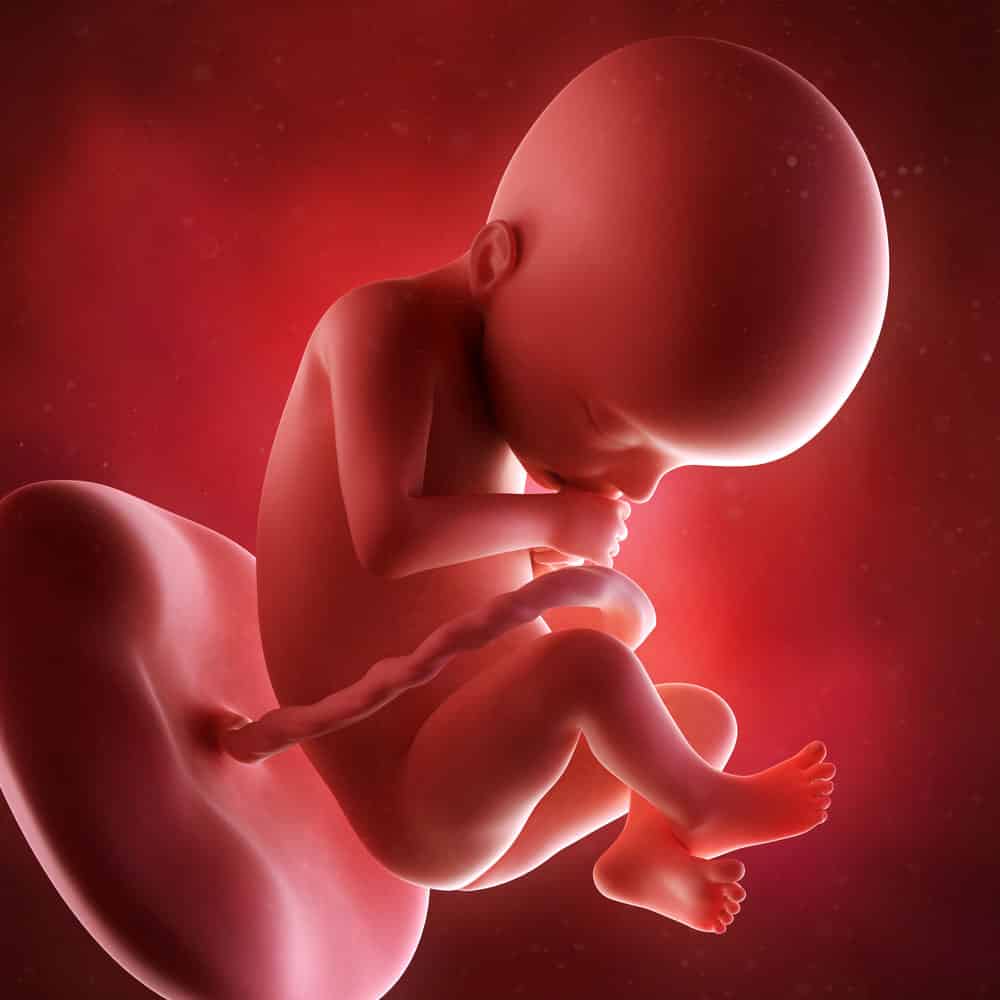
- Average fetal length at 22 weeks: 10.5 inches
- Average fetal weight at 22 weeks: 15 ounces
Those precious little eyelids are still sealed shut, but the baby can see light shining through its lids (try shining a flashlight on your belly to see if it wiggles!). Baby is also getting good at grabbing, and until it can get to your hair and jewelry, it’s practicing on its face and umbilical cord.
Pregnancy Week 22 Symptoms & Baby Bumps
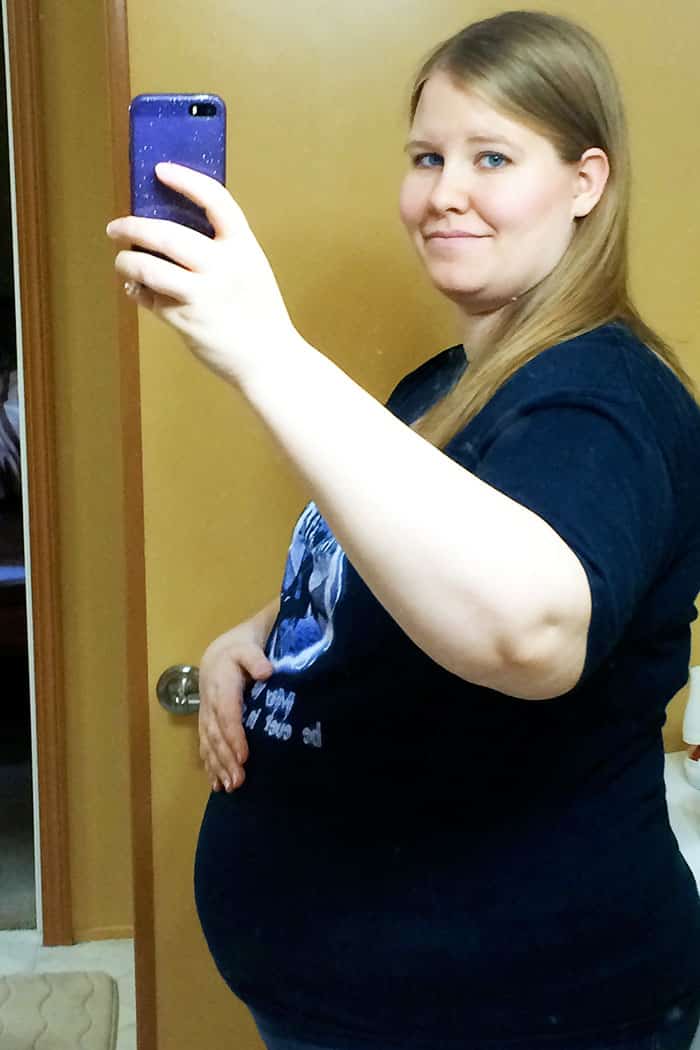
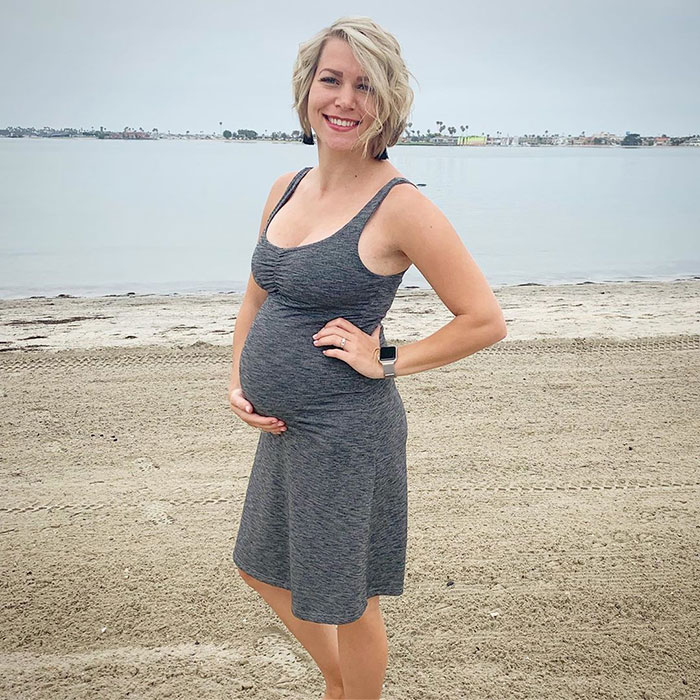
If you feel your belly (uterus) hardening or squeezing for a few seconds before relaxing, but there’s no pain, don’t panic! Those likely aren’t real contractions, but they are practice ones. They’re called Braxton-Hicks contractions, and they’re like exercises your uterus performs to prepare for the big day.
Usually, they don’t start till closer to the end of pregnancy, but women have reported feeling them this early. If they do become painful or start coming at frequent, regular intervals for an hour or more, contact your doctor immediately!
Continuing symptoms:
- color-changing breasts
- food cravings
- heartburn
- gas
- vaginal discharge
- constipation
- dizziness
- increased OR decreased sex drive
- varicose veins
- round ligament pain
- increased mucus and oil production
- sensitive gums
- forgetfulness
- stretch marks
- backaches
- leg cramps
- swelling
- fast-growing hair and nails
Pregnancy Week 22 Video
This post may contain affiliate links. If you make a purchase after clicking one, I may receive a small commission at no cost to you.
Pregnancy Week 23 Development
How many months pregnant is 23 weeks?
23 weeks equals over five months pregnant!
Where is the baby located at 23 weeks?
Your uterus is about 1.5 inches above your belly button now. Since your baby is now starting to hear and listen inside the womb, the closer the baby (literally) grows to your heart, the more your heart will become its favorite sound. I’m not crying YOU’RE CRYING!
What does a baby look like at 23 weeks?
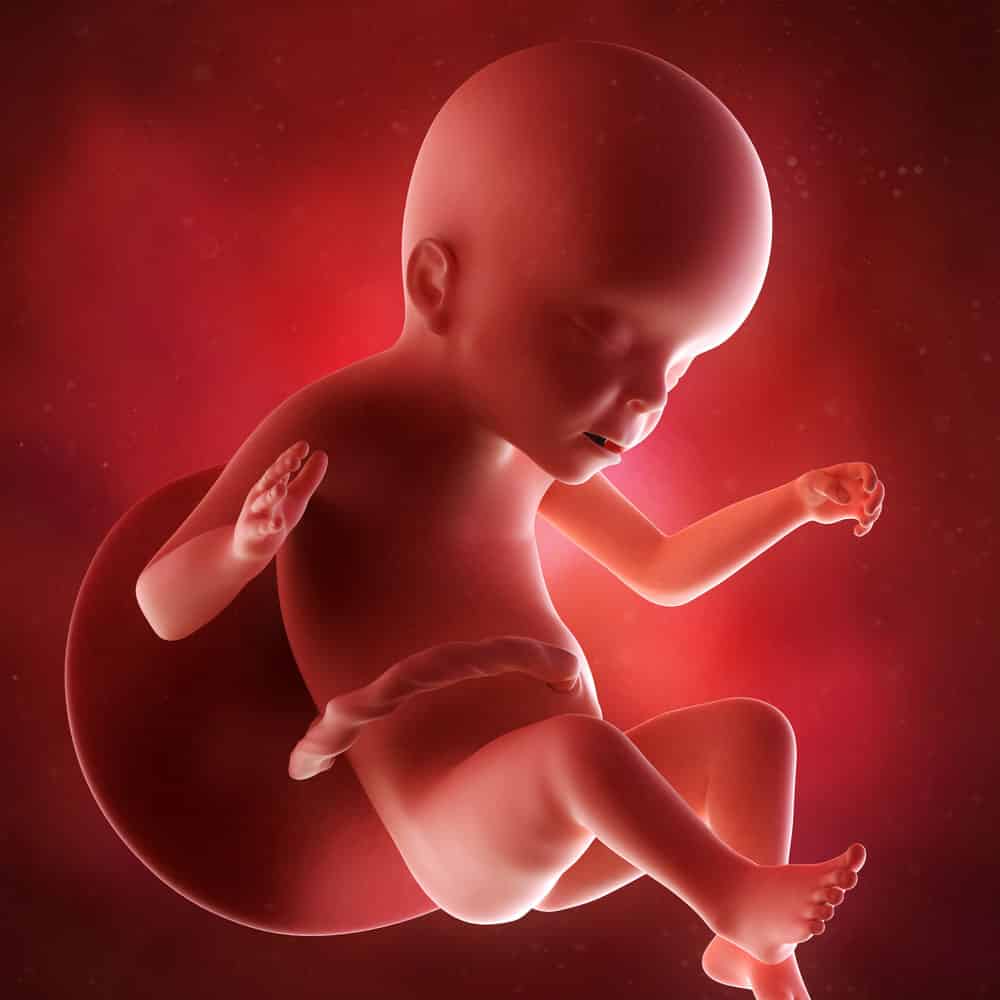
- Average fetal length at 23 weeks: 12 inches
- Average fetal weight at 23 weeks: over 1 pound!
Baby’s looking a bit pink these days, thanks to all the veins and arteries growing under its translucent skin. Speaking of skin, the baby’s is probably looking a bit droopy right now, but all that excess skin will soon fill up with adorably plump baby fat. Until then, you can see the bones and organs under the surface! The lanugo (fine hair) on its body may darken, allowing it to be seen on an ultrasound!
With any luck, from now on you’ll be able to hear the baby’s heartbeat with a stethoscope instead of having to use a doppler! Stethoscopes aren’t just for nurses, either; you can get a reasonably priced stethoscope on Amazon.
Pregnancy Week 23 Symptoms & Baby Bumps


Those lovely growth hormones are going absolutely wild in your body now. They can be responsible for red palms and feet, skin tags, and heat rash… Oh my!
If you’ve been keeping an eye out for that vertical dark line on your belly pregnant women always seem to have, it’s probably starting to show now. It should be the same color as your darkening areolas (whose nipples ARE these, anyway??). This line is called the linea nigra, and it’s more prominent in darker-skinned women.
Dark spots may even show up on your face, which is referred to as the mask of pregnancy (or melasma). Consider it the trade-off of being less likely to have stretch marks that the fair-skinned are prone to!
If you are of the whiter variety (like me), you’re not exempt from the linea nigra. Mine showed up as a faint, reddish-brown line from several inches above my belly button down to an inch or so above my pubic hair. And yes, my pale areolas became the same reddish-brown color and stayed that way for many weeks after delivery (for as long as I attempted to breastfeed my children).
Continuing symptoms:
- color-changing breasts
- food cravings
- heartburn
- gas
- vaginal discharge
- constipation
- dizziness
- increased OR decreased sex drive
- varicose veins
- round ligament pain
- increased mucus and oil production
- sensitive gums
- forgetfulness
- stretch marks
- backaches
- leg cramps
- swelling
- fast-growing hair and nails
- Braxton-Hicks contractions
Pregnancy Week 23 Video
Pregnancy Week 24 Development
How many months pregnant is 24 weeks?
24 weeks equals five-and-a-half months pregnant!
Where is the baby located at 24 weeks?
The fundus is about 2 inches above your belly button now, and your baby is likely still head-up, making it feel like your abdomen will burst open any moment. Cherish that feeling, for now – it only gets worse when the baby flips, and those cute little feet have access to your rib cage!
What does a baby look like at 24 weeks?
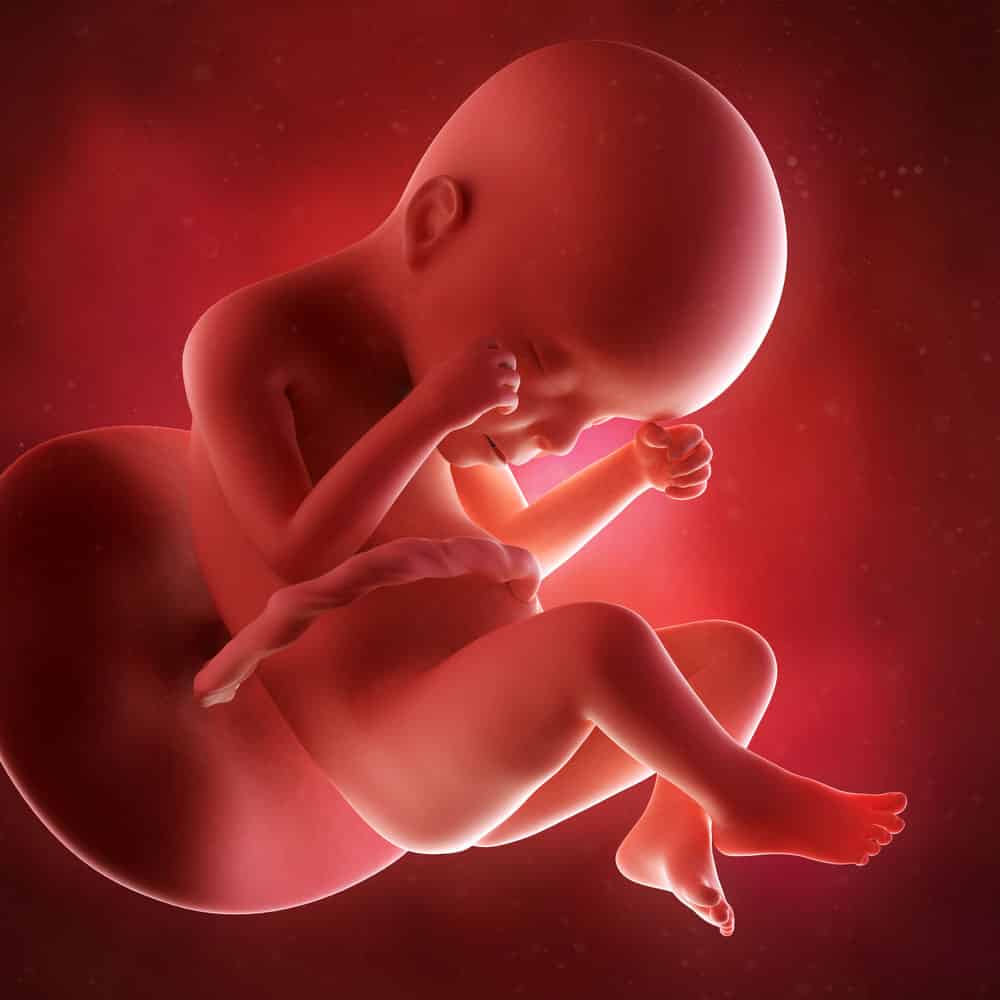
- Average fetal length at 24 weeks: 12.5 inches
- Average fetal weight at 24 weeks: 1.4 pounds
Little bean’s auditory system has developed to the point that it can probably recognize songs it hears frequently and will be soothed by them after it’s born. Start singing those lullabies, mama! However, this means very loud sounds like sirens can be heard in the womb, so it wouldn’t hurt to put a blanket over your belly in extra-loud situations.
Baby’s also covered in hair, including eyelashes – but it’s probably all white! (At least until the pigment kicks in.) The brain is growing rapidly, and taste buds are forming. The main branches of the lungs are forming as well.
24-Week Preemie Survival Rate
With all of the potential health problems pregnancy brings, it can be difficult not to wonder what the odds are of your baby surviving should something go wrong in your body. It’s hard enough miscarrying a baby in the first trimester, but now? After it looks like a teeny tiny version of a full-term baby? It’s a heartbreaking thought.
The good news is, 24 weeks is the turning point for when a prematurely delivered baby is more likely to survive than not. Many hospitals will resuscitate a baby born at 24 weeks (rather than just making it comfortable). There are some factors that hint at a higher rate of survival, including a higher birth weight at 24 weeks, being female, and being born via c-section rather than vaginally (so if you think you might be in premature labor, get to your local hospital ASAP!).
I’m not even pregnant now, and typing those statistics out started the waterworks for me. My apologies to you expectant mothers reading this! I’ve included this information because I want you to have solid facts about what can happen in your pregnancy and with your baby, and I want you to be prepared for all scenarios before they happen. The most important thing you can have in the case of premature childbirth is optimism. Never give up hope! Your baby will be able to feel it.
Pregnancy Week 24 Symptoms & Baby Bumps
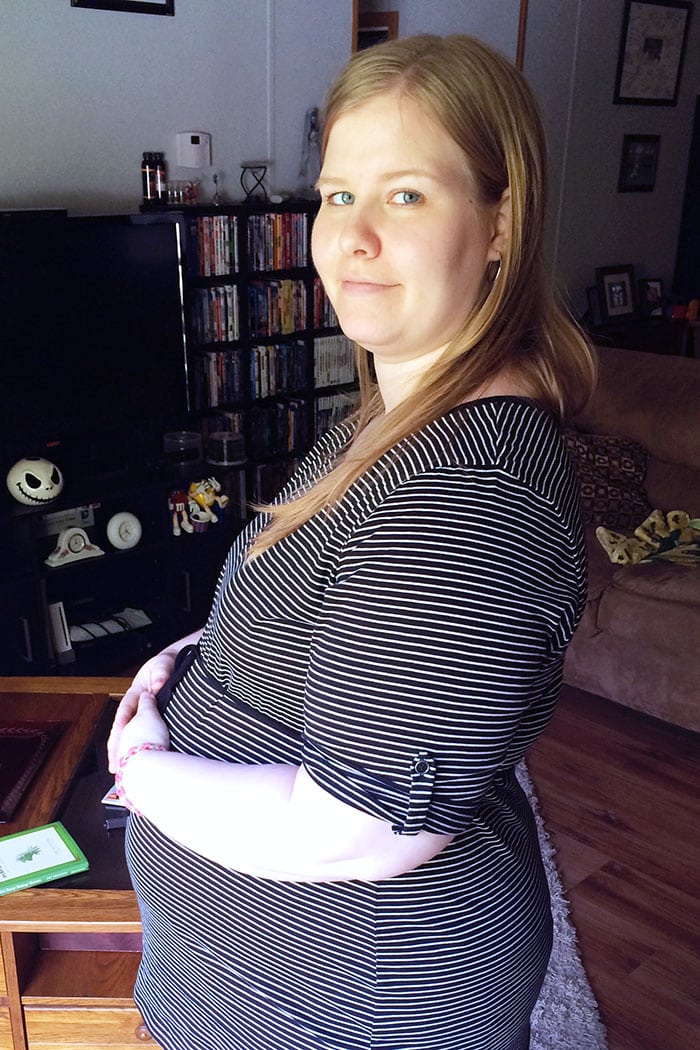
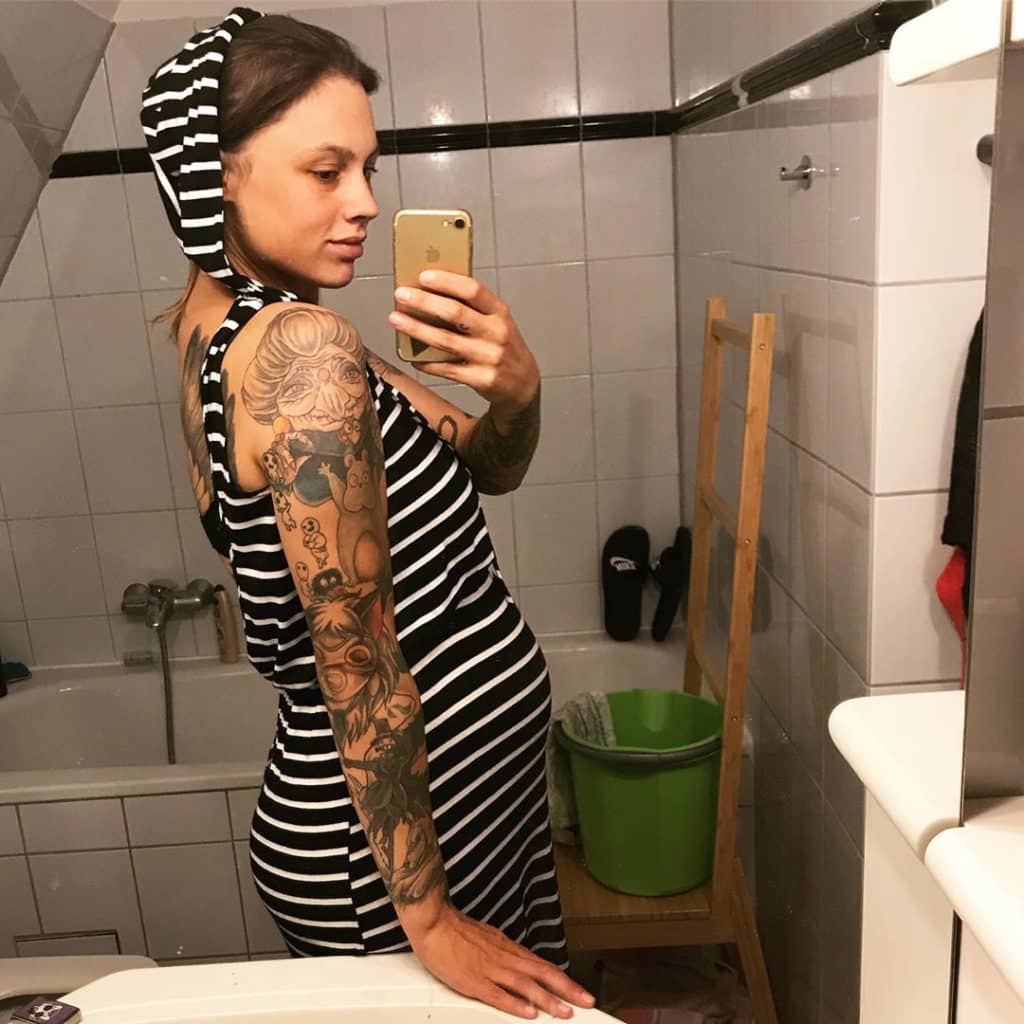
A side effect of swelling (wait, isn’t that already the side effect?) that may show up now is carpal tunnel syndrome – the numb, tingling sensation in your hands and fingers. If you do a lot of repetitive finger-work, like typing or piano-playing, it can be more severe. Take frequent breaks to stretch your hands and wrists, or even put on a wrist brace if the numbness persists. Fortunately, this symptom should go away after delivery as soon as the swelling does.
If those red palms and feet are getting extra hot and itchy, you can find relief by putting your feet in cold water (I recommend using a large foot bathtub with room for ice) and resting your hands on ice packs wrapped in tea towels.
Blurry vision got you stumbling more than your super-sized feet? That’s a pregnancy symptom, too! It’s a result of dry eyes on the outside combined with fluid buildup on the inside of your eyes. This will also go away post-birth, but be sure to tell your ophthalmologist you’re pregnant during your checkup; it’s generally not a good idea to change prescriptions while pregnant when the change is likely temporary.
Sometime between 24 and 28 weeks, your doctor should perform a glucose test to check for gestational diabetes. Some of the signs align with normal pregnancy symptoms: nausea, fatigue, and frequent urination. But one, in particular, stands out: extreme thirst. If you can’t stop guzzling water throughout the day, you may have developed gestational diabetes. 2-5% of all women do.
If you’re overweight or obese, your risk of gestational diabetes is 5-10 times higher than that of a woman at a healthy weight, roughly 25%. That being said, the risk of GD for ALL women correlates strongly to the amount of weight gained throughout pregnancy, meaning the more weight gained, the more likely you are to develop GD. Keeping your calorie intake the same (or a little less) as it was prior to pregnancy will help mitigate your risk.
Women of a healthy weight should not try to lose or “maintain” weight while pregnant, but limiting your gain to 25 pounds will reduce your risk of GD as well. I only gained around 10 pounds in my first pregnancy and lost 10 pounds during my second (both were totally fine since I was obese), and I never developed gestational diabetes with either – so being fat is definitely not the only factor!
Continuing symptoms:
- food cravings
- heartburn
- gas
- vaginal discharge
- constipation
- dizziness
- increased OR decreased sex drive
- varicose veins
- round ligament pain
- increased mucus and oil production
- sensitive gums
- forgetfulness
- stretch marks
- backaches
- leg cramps
- swelling
- fast-growing hair and nails
- Braxton-Hicks contractions
- skin discoloration


